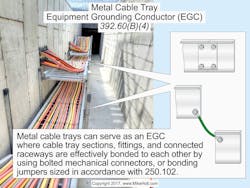Stumped By the Code? Rules for Cable Tray to Be Used as an EGC
All questions and answers are based on the 2017 NEC.
Q. Does the NEC allow a cable tray to be used as an equipment grounding conductor (EGC)?
A. Metal cable trays can be used as EGCs where continuous maintenance and supervision ensure that only qualified persons service the cable tray system [Sec. 392.60(A)]. Metal cable trays containing single conductors must be bonded together to ensure they have the capacity to conduct safely any fault current likely to be imposed in accordance with Sec. 250.96(A).Metal cable trays containing communications, data, and signaling conductors and cables must be electrically continuous through approved connections or the use of a bonding jumper. Metal cable trays can serve as EGCs where the following requirements have been met [Sec. 392.10(B) and (C)]:(1) Metal cable trays and fittings are identified as an EGC.(4) Cable tray sections, fittings, and connected raceways are effectively bonded to each other to ensure electrical continuity and the capacity to conduct safely any fault current likely to be imposed on them [Sec. 250.96(A)]. This is accomplished by using bolted mechanical connectors or bonding jumpers sized in accordance with Sec. 250.102 (Figure).Q. What is the Code requirement for the physical location of overcurrent protection devices?
A. Circuit breakers and switches containing fuses must be readily accessible and installed so the center of the grip of the operating handle of the circuit breaker or switch, when in its highest position, isn’t more than 6 ft 7 in. above the floor or working platform, except for [Sec. 240.24(A)]:
(1) Busways, as provided in Sec. 368.17(C).
(2) Supplementary overcurrent protection devices per Sec. 240.10.
(3) For overcurrent protection devices, as described in Sec. 225.40 and Sec. 230.92.
(4) Circuit breakers and switches containing fuses are permitted above
6 ft 7 in. where located next to equipment if accessible by portable means [Sec. 404.8(A), Exception No. 2].
Exception. The use of a tool is permitted to access overcurrent protection devices located within listed industrial control panels or similar enclosures.
Overcurrent protection devices aren’t permitted to be exposed to physical damage [Sec. 240.24(C)].
Informational Note: Electrical equipment must be suitable for the environment, and consideration must be given to the presence of corrosive gases, fumes, vapors, liquids, or chemicals that have a deteriorating effect on conductors or equipment [Sec. 110.11].
Overcurrent protection devices aren’t permitted to be located near easily ignitable material, such as in clothes closets [Sec. 240.24(D)].
Overcurrent protection devices aren’t permitted to be located in the bathrooms of dwelling units, dormitories, or guest rooms or guest suites of hotels or motels [Sec. 240.24(D)]. The service disconnect switch isn’t permitted to be located in a bathroom, even in commercial or industrial facilities [Sec. 230.70(A)(2)].
Overcurrent protection devices aren’t permitted to be located over the steps of a stairway [Sec. 240.24(F)], as it’s difficult for electricians to safely work on electrical equipment that’s located on uneven surfaces such as over stairways.
These materials are provided to us by Mike Holt Enterprises in Leesburg, Fla. To view Code training materials offered by this company, visit www.mikeholt.com/code.






